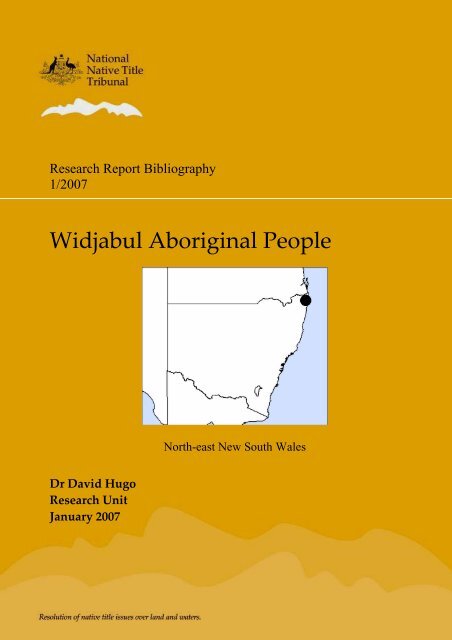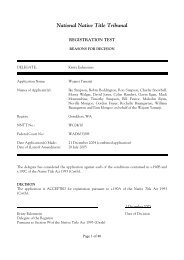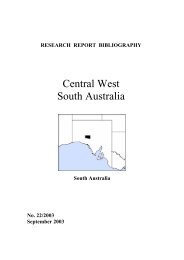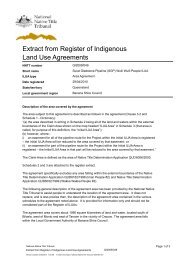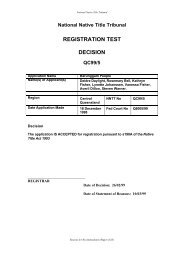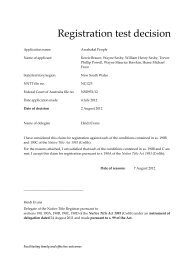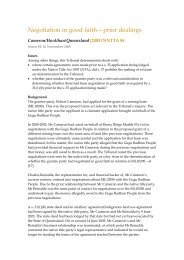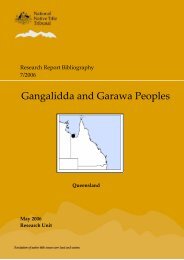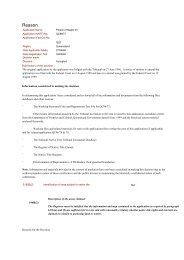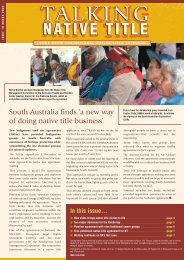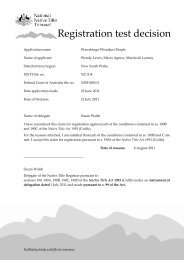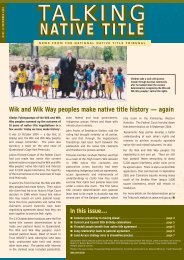Widjabul Aboriginal People - National Native Title Tribunal
Widjabul Aboriginal People - National Native Title Tribunal
Widjabul Aboriginal People - National Native Title Tribunal
- No tags were found...
You also want an ePaper? Increase the reach of your titles
YUMPU automatically turns print PDFs into web optimized ePapers that Google loves.
Research Report Bibliography1/2007<strong>Widjabul</strong> <strong>Aboriginal</strong> <strong>People</strong>North-east New South WalesDr David HugoResearch UnitJanuary 2007
Note: This bibliographic series is produced for general library viewing fromreports prepared by the <strong>Tribunal</strong> for parties to native title mediations. Thebibliographies are also reproduced on the <strong>Tribunal</strong>’s website:www.nntt.gov.au© Commonwealth of Australia 2007This work is copyright. It may be reproduced in whole or in part for study ortraining purposes if an acknowledgment of the source is included. Such usemust not be for the purposes of sale or commercial exploitation.Subject to the Copyright Act, reproduction, storage in a retrieval system ortransmission in any form by any means of any part of the work other than forthe purposes above is not permitted without written permission.Information about this report and requests and inquiries concerningreproduction should be addressed to, Manager, Research Unit, <strong>National</strong><strong>Native</strong> <strong>Title</strong> <strong>Tribunal</strong>, GPO Box 9973, Perth WA 6484.Editor of the Research Report Series: Research UnitAssistance is also acknowledged from NNTT Library Services, AIATSISLibrary and the Research Unit’s Production Team.Telephone: (08) 9268 7272Facsimile: (08) 9268 7299E-mail: reports@nntt.gov.auWeb site: www.nntt.gov.auISSN: 1448-983XTITLE: Research Report Bibliographies
Bibliography<strong>Widjabul</strong> <strong>Aboriginal</strong> <strong>People</strong>IntroductionThe <strong>Tribunal</strong>’s Research Unit prepares bibliographies as a readyreference for anyone wanting to locate readily available, publishedmaterial about Indigenous Australian people within a particularregion or locality. The bibliographies are produced for general libraryuse from reports prepared by the <strong>Tribunal</strong> for parties to native titlemediations. The bibliographies are not exhaustive reference listsabout any particular Indigenous group, nor is the published materialnecessarily an accurate or insightful report of Indigenous society. TheResearch Unit may update bibliographies from time to time, usuallybecause a new research report has been reproduced for parties tomediation.It should be noted that the contents and production of these reportsare governed by time and resource constraints. They are oftenprepared in four to eight weeks by a single research officer with someinput from a research assistant and <strong>Tribunal</strong> librarian. Generallymost of the references sought for these reports are available only fromthe AIATSIS library, which in turn has limited resources available tosupply material. Therefore care is taken to request only that materialwhich appears relevant to the scope of a particular report.Disclaimer: The bibliographies are a list of materials that have beenused by the Research Unit of the <strong>Tribunal</strong> to provide backgroundinformation for native title mediations. The <strong>Tribunal</strong> forms no viewon the accuracy, completeness, or relevance of the reference materialcited in these bibliographies. Most of this material is held at librariesand is available to the public. The <strong>Tribunal</strong> library may be able toassist in locating items.- 1 -
Bibliography<strong>Widjabul</strong> <strong>Aboriginal</strong> <strong>People</strong><strong>Widjabul</strong> <strong>Aboriginal</strong> <strong>People</strong>This report was prepared by staff of the Research Unit of the <strong>National</strong><strong>Native</strong> <strong>Title</strong> <strong>Tribunal</strong>, in order to assist with the mediation of a nativetitle claim by the <strong>Widjabul</strong> <strong>Aboriginal</strong> <strong>People</strong> of the Lismore region innorth-east New South Wales. A native title claim on behalf of the<strong>Widjabul</strong> people has been registered to date:• <strong>Widjabul</strong> <strong>Aboriginal</strong> <strong>People</strong> (NC01/7; NSD6019/01);The <strong>Widjabul</strong> <strong>Aboriginal</strong> <strong>People</strong>'s claim is located inland from CapeByron in the State of New South Wales and covers an area of about1617 km sq. The claim extends from a point north of Coraki on thenorthern side of the Richmond River near Ruthven and travels eastacross the southern border of the Tuckean Nature Reserve. Theboundary then travels north along the Blackwall Range through thetowns of Wollongbar and Tyumba to a point south of Coorabell thennorthwest towards Palmwoods along the Koonyum Range. Theboundary then runs west through the Nightcap <strong>National</strong> Park to BlueNob and a small finger of land runs north into the Mebbin NatureReserve. The boundary then continues south through UpperHorseshoe Creek and skirts east of Kyogle and then southeastthrough the towns of Spring Grove and McKees Hill to Ruthven.Research MethodThis report is based on publicly and readily available information thatdescribes the location of the <strong>Widjabul</strong> and other Indigenous peoples(Arakwal, Minjungbal and Kalibal people) in the area covered by theclaim NC01/7. It should be noted that the content and production ofthese reports are governed by time and resource constraints. They areusually prepared in six weeks by a single research officer with someinput from a research assistant and a <strong>Tribunal</strong> librarian.- 2 -
Bibliography<strong>Widjabul</strong> <strong>Aboriginal</strong> <strong>People</strong>The material used for these reports is derived largely from a search ofthe AIATSIS online catalogue. A large proportion of this material isavailable only from the AIATSIS library, which has limited resourcesavailable to supply material. Therefore care is taken to request onlythat material which appears relevant to the scope of a particularreport.The <strong>Tribunal</strong> Library also has substantial holdings of referencematerial which is used where appropriate. In addition, a number ofgeneral references were used, including:• Capell, 1963, Linguistic Survey of Australia;• Horton, 1996, <strong>Aboriginal</strong> Australia;• Tindale, 1940, 'Distribution of Australian <strong>Aboriginal</strong> tribes: a fieldsurvey'; and• Tindale, 1974, <strong>Aboriginal</strong> Tribes of Australia; andThis report contains summaries of information that is publiclyavailable and relevant to the location of the Arakwal, Minjungbal,Kalibal and <strong>Widjabul</strong> peoples relating only to the areas that form partof the native title claim. These four groups are reflected in theliterature as having an association with the region. Additionally, asearch was conducted of the language term 'Bundjalung' since thisterm is used in the literature to describe a larger language group towhich the above four 'dialects' may have belonged.The literature contains much salvage linguistic work from the 1960sonwards, as well as other material by researchers associated with theRichmond-Tweed Historical Society based in Lismore. This researchmaterial has a fair component of contact history, and a similaramount of material from living <strong>Aboriginal</strong> people with knowledge ofpast practices and aspects of cultural history. This information,gathered in the period from the 1960s, is valuable though oftenrepetitive. Information relating to the location of <strong>Aboriginal</strong> groupswithin the claim area has been reported only once. Subsequentaccounts of the same information have been omitted.- 3 -
Bibliography<strong>Widjabul</strong> <strong>Aboriginal</strong> <strong>People</strong>A search was made of the AIATSIS library catalogue using thegroups’ ‘language group’ names.Each record was examined to determine its likely relevance orusefulness. Materials with access restrictions were omitted as wereforeign language materials, obvious apparent cataloguing errors,microforms, audio material and material that appeared to deal withtechnical aspects of language or education curricula. The result ofthese searches is set out in the table below:Search termRawresultAfterfilteringNotesLanguage Group: Arakwal 10 6 Number of purely linguisticarticles filtered outLanguage Group: Minjungbal 69 25 Numerous articles purely onlinguistics, and duplicatedsources.Language Group: Kalibal 0 Term not used in AIATSISdatabase though usedthroughout the literatureLanguage group: Widjabal 20 13 Some duplicationLanguage group: Bunjalung 193 85 Large number of sound files, alsonumerous articles purely onlinguistics, items with restrictedaccess and transcripts ofexcessive lengthTotal 292 129- 4 -
Bibliography<strong>Widjabul</strong> <strong>Aboriginal</strong> <strong>People</strong>BibliographyAustralian Institute of <strong>Aboriginal</strong> Studies Library, 'Manuscript Finding Aid for MS 2900Papers of Malcolm John Chalmers Calley', n.d.Australian Institute of <strong>Aboriginal</strong> Studies Library, 'Manuscript Finding Aid MS 3803Papers of Marjorie J. Oakes', n.d.Calley, M.J.C. 1955, '<strong>Aboriginal</strong> Pentecostalism: A Study of changes in religion, northcoast, N.S.W.', M.A. thesis, University of Sydney.Capell, A. 1963, Linguistic Survey of Australia, Australian Institute of <strong>Aboriginal</strong> Studies,Canberra.Crowley, T. 1978, The Middle Clarence dialects of the Bandjalang, Australian <strong>Aboriginal</strong>Studies Research and Regional Studies No. 12, Australian Institute of <strong>Aboriginal</strong>Studies, Canberra.Curr, E. M. 1886, The Australian Race: its origins, languages, customs, place of landing inAustralia, and the routes by which it spread itself over that continent. Vol. II.Government Printer, Melbourne.Davidson, D.S. 1938a, A Preliminary Register of Australian Tribes and Hordes, The AmericanPhilosophical Society, Philadelphia.Davidson, D.S. 1938b, ‘An Ethnic Map of Australia’, Proceedings of the AmericanPhilosophical Society, vol. 79, no. 4.Geytenbeek, B. & H., 1971, Gidabal grammar and dictionary, Australian Institute of<strong>Aboriginal</strong> Studies, Canberra.Gordon, J. 1968, 'Survey of <strong>Aboriginal</strong> music in N.S.W.', AIATSIS document numberPMS2197.Hausfeld, R.G. 1960, 'Aspects of <strong>Aboriginal</strong> station management', M.A. thesis, Universityof Sydney.Heron, R. 1991, ‘<strong>Aboriginal</strong> perspectives: An Ethnohistory of six <strong>Aboriginal</strong>communities in the Clarence valley’, B. Letters, Australian <strong>National</strong> University,Canberra.Horton, D. (ed.) 1994. The Encyclopaedia of <strong>Aboriginal</strong> Australia, Australian Institute of<strong>Aboriginal</strong> and Torres Strait Islander Studies, Canberra.Keats, N.C. 1988, "Wollumbin": The Creation and early habitation of the Tweed Brunswick and`Richmond rivers of N.S.W., The Book Printer, Woy Woy, New South Wales.Livingstone, H. 1892, 'A Short grammar and vocabulary of the dialect spoken by theMinyung people on the north-east coast of New South Wales', in Threlkeld, L.E.- 5 -
Bibliography<strong>Widjabul</strong> <strong>Aboriginal</strong> <strong>People</strong>An Australian language as spoken by the Awabakal, the people of Awaba or LakeMacquarie being an account of their language, traditions and customs, GovernmentPrinter Sydney.Prentis, M.D. 1972, ‘Aborigines and Europeans in the Northern Rivers region of NewSouth Wales, 1823-1881’, M.A. thesis, Macquarie University.Sharpe, M. 1985, 'Bundjalung settlement and migration', <strong>Aboriginal</strong> History, Vol.9, part 1,pages 101-124.Smythe, W.E. [1978] Bandjalang Grammar, In Crowley, T. 1978, The Middle Clarence dialectsof the Bandjalang, Australian <strong>Aboriginal</strong> Studies Research and Regional StudiesNo. 12, Australian Institute of <strong>Aboriginal</strong> Studies, Canberra.Tindale, N.B. 1940, 'Distribution of Australian <strong>Aboriginal</strong> Tribes: A Field Survey', RoyalSociety of South Australia, 64(1).Tindale, N. B. 1974, <strong>Aboriginal</strong> Tribes of Australia: Their Terrain, Environmental Controls,Distribution, Limits, and Proper Names, University of California Press, Berkeley.- 6 -
For more information about native titleand services of the <strong>Tribunal</strong>, please contactthe <strong>National</strong> <strong>Native</strong> <strong>Title</strong> <strong>Tribunal</strong>GPO Box 9973 in your capital city onFreecall 1800 640 501. A wide variety ofinformation is also available online atwww.nntt.gov.auThe <strong>National</strong> <strong>Native</strong> <strong>Title</strong> <strong>Tribunal</strong> hasoffices in Adelaide, Brisbane, Cairns, Darwin,Melbourne, Perth and Sydney.


